The Adaptability of Different Wheat Varieties to Deep Sowing in Henan Province of China
Abstract
1. Introduction
2. Materials and Methods
2.1. Plant Materials and Growing Conditions
2.2. Seedling Emergence Time and Emergence Rate
2.3. Coleoptile Length, Coleoptile Internode and Seedling Height
2.4. Latest Fully Expanded Leaf Area
2.5. Shoot Dry Weight per Unit Area
2.6. Deep Sowing Resistance Coefficient (DSRC)
2.7. Membership Function Values of the Deep Sowing Resistance Coefficient of Each Trait
2.8. Weights of Comprehensive Indicators
2.9. Calculation of Comprehensive Deep Sowing Tolerance
2.10. Statistical Analysis
3. Results
3.1. Effects of Sowing Depth on the Emergence Rate of Different Wheat Varieties
3.2. Effects of Deep Sowing on Wheat Germination Characteristics and Seedling Phenotypes
3.3. Correlation Analysis of Deep Sowing Traits of Wheat During Seed Germination
3.4. Principal Component Analysis of Deep Sowing Traits of Different Wheat Varieties
3.5. Classification of Wheat Varieties According to Deep Sowing Tolerance
3.6. Screening of Indicators for Deep Sowing Tolerance of Wheat During Seed Germination
4. Discussion
5. Conclusions
Author Contributions
Funding
Data Availability Statement
Conflicts of Interest
Appendix A
| Number | Variety | Seedling Emergence Rate at Different Depths | ||||
|---|---|---|---|---|---|---|
| 3 cm | 5 cm | 7 cm | 9 cm | 11 cm | ||
| 1 | Fanmai 5 | 0.99 ± 0.01 | 0.91 ± 0.05 | 0.93 ± 0.05 | 0.77 ± 0.11 | 0.62 ± 0.09 |
| 2 | Bainong 4199 | 0.95 ± 0.03 | 0.91 ± 0.02 | 0.91 ± 0.03 | 0.75 ± 0.04 | 0.47 ± 0.09 |
| 3 | Zhongmai 895 | 0.95 ± 0.05 | 0.89 ± 0.08 | 0.91 ± 0.04 | 0.75 ± 0.06 | 0.75 ± 0.12 |
| 4 | Zhengmai 0919 | 0.95 ± 0.02 | 0.93 ± 0.02 | 0.93 ± 0.04 | 0.79 ± 0.03 | 0.58 ± 0.12 |
| 5 | Zhengmai 661 | 0.97 ± 0.01 | 0.95 ± 0.04 | 0.94 ± 0.05 | 0.84 ± 0.11 | 0.62 ± 0.1 |
| 6 | Zhengmai 1354 | 0.95 ± 0.01 | 0.95 ± 0.03 | 0.9 ± 0.05 | 0.77 ± 0.05 | 0.58 ± 0.02 |
| 7 | Xinmai 26 | 0.99 ± 0.01 | 0.97 ± 0.03 | 0.92 ± 0.05 | 0.74 ± 0.03 | 0.52 ± 0.02 |
| 8 | Aikang 58 | 0.97 ± 0.02 | 0.92 ± 0.02 | 0.95 ± 0.05 | 0.79 ± 0.1 | 0.72 ± 0.06 |
| 9 | Zhengmai 662 | 0.87 ± 0.03 | 0.86 ± 0.02 | 0.77 ± 0.04 | 0.66 ± 0.02 | 0.52 ± 0.11 |
| 10 | Xinong 511 | 0.93 ± 0.07 | 0.88 ± 0.05 | 0.89 ± 0.03 | 0.63 ± 0.15 | 0.61 ± 0.05 |
| 11 | Zhengmai 136 | 0.93 ± 0.02 | 0.91 ± 0.01 | 0.91 ± 0.01 | 0.77 ± 0.03 | 0.7 ± 0.09 |
| 12 | Wanfeng 269 | 0.91 ± 0.08 | 0.95 ± 0.03 | 0.9 ± 0.03 | 0.79 ± 0.08 | 0.63 ± 0.17 |
| 13 | Zhengmai 379 | 0.93 ± 0.04 | 0.92 ± 0.04 | 0.88 ± 0.04 | 0.77 ± 0.05 | 0.55 ± 0.07 |
| 14 | Zhengmai 1860 | 0.95 ± 0.01 | 0.88 ± 0.03 | 0.84 ± 0.05 | 0.81 ± 0.06 | 0.51 ± 0.01 |
| 15 | Zhengmai 0943 | 0.9 ± 0.04 | 0.91 ± 0.04 | 0.87 ± 0.04 | 0.7 ± 0.04 | 0.55 ± 0.21 |
| 16 | Zhengmai 20 | 0.93 ± 0.01 | 0.94 ± 0 | 0.89 ± 0.03 | 0.86 ± 0.04 | 0.72 ± 0.05 |
| 17 | Zhengmai 369 | 0.85 ± 0.07 | 0.77 ± 0.05 | 0.75 ± 0.05 | 0.55 ± 0.1 | 0.33 ± 0.03 |
| 18 | Fanmai 8 | 0.87 ± 0.06 | 0.76 ± 0.04 | 0.77 ± 0.12 | 0.63 ± 0.13 | 0.38 ± 0.07 |
| 19 | Zhoumai 22 | 0.93 ± 0.04 | 0.82 ± 0.03 | 0.81 ± 0.01 | 0.65 ± 0.08 | 0.47 ± 0.09 |
| 20 | Zhengmai 22 | 0.94 ± 0.02 | 0.91 ± 0.01 | 0.85 ± 0.01 | 0.67 ± 0.01 | 0.46 ± 0.23 |
| 21 | Xinmai 45 | 0.88 ± 0.07 | 0.81 ± 0.05 | 0.67 ± 0.09 | 0.49 ± 0.05 | 0.43 ± 0.05 |
| 22 | Zhengmai 113 | 0.85 ± 0.1 | 0.75 ± 0.08 | 0.72 ± 0.09 | 0.63 ± 0.08 | 0.41 ± 0.05 |
| 23 | Hemai 1707 | 0.85 ± 0.01 | 0.79 ± 0.01 | 0.78 ± 0.02 | 0.63 ± 0.02 | 0.51 ± 0.06 |
| 24 | Jimai 22 | 0.88 ± 0.05 | 0.83 ± 0.06 | 0.73 ± 0.08 | 0.58 ± 0.05 | 0.27 ± 0.01 |
| 25 | Zhengmai 16 | 0.87 ± 0.06 | 0.79 ± 0.06 | 0.76 ± 0.07 | 0.65 ± 0.06 | 0.58 ± 0.09 |
| 26 | Zhengmai 7698 | 0.85 ± 0.02 | 0.77 ± 0.03 | 0.71 ± 0.09 | 0.63 ± 0.09 | 0.5 ± 0.11 |
| Average | 0.92 ± 0.04 | 0.87 ± 0.04 | 0.84 ± 0.05 | 0.7 ± 0.07 | 0.54 ± 0.08 | |
| CV% | 4.9% | 7.84% | 9.8% | 13.38% | 22.27% | |
| Parameter | ET (%) | CL (cm) | CI (cm) | ET (d) | SH (cm) | SDW (g/m2) | LA (cm2) | |||||||
|---|---|---|---|---|---|---|---|---|---|---|---|---|---|---|
| 3 cm | 9 cm | 3 cm | 9 cm | 3 cm | 9 cm | 3 cm | 9 cm | 3 cm | 9 cm | 3 cm | 9 cm | 3 cm | 9 cm | |
| Maximum | 99.33 | 86.00 | 4.74 | 7.62 | 2.52 | 6.77 | 7.57 | 10.23 | 23.5 | 20.52 | 45.17 | 29.72 | 5.66 | 4.66 |
| Minimum | 84.67 | 49.33 | 3.41 | 5.65 | 0.84 | 4.73 | 4.83 | 7.57 | 14.72 | 14.37 | 27.37 | 16.25 | 3.03 | 2.36 |
| Average | 91.67 | 70.41 | 4.10 | 6.76 | 1.73 | 5.46 | 6.43 | 8.81 | 18.49 | 16.71 | 34.93 | 21.82 | 4.20 | 3.40 |
| Standard deviation | 4.49 | 9.42 | 0.37 | 0.56 | 0.45 | 0.52 | 0.71 | 0.66 | 1.91 | 1.26 | 4.93 | 3.08 | 0.71 | 0.51 |
| Coefficient of variation (%) | 4.90 | 13.38 | 8.91 | 8.33 | 25.86 | 9.59 | 11.07 | 7.54 | 10.32 | 7.53 | 14.12 | 14.11 | 16.81 | 14.95 |
| Variety | X1 | X2 | X3 | X4 | X5 | X6 | X7 |
|---|---|---|---|---|---|---|---|
| Fanmai 5 | 1.42 | 0.62 | 1.78 | 5.28 | 0.90 | 1.01 | 0.77 |
| Bainong 4199 | 1.31 | 0.67 | 1.65 | 2.54 | 1.03 | 0.68 | 0.79 |
| Zhongmai 895 | 1.46 | 0.63 | 1.80 | 3.34 | 0.91 | 0.78 | 0.79 |
| Zhengmai 0919 | 1.41 | 0.75 | 1.64 | 2.77 | 0.95 | 1.02 | 0.83 |
| Zhengmai 661 | 1.44 | 0.70 | 1.62 | 3.19 | 0.88 | 0.85 | 0.87 |
| Zhengmai 1354 | 1.34 | 0.64 | 1.84 | 3.13 | 0.84 | 0.80 | 0.81 |
| Xinmai 26 | 1.31 | 0.58 | 1.54 | 2.66 | 0.88 | 0.85 | 0.75 |
| Aikang 58 | 1.29 | 0.56 | 1.70 | 2.43 | 0.93 | 0.78 | 0.82 |
| Zhengmai 662 | 1.37 | 0.59 | 1.59 | 2.86 | 0.84 | 0.86 | 0.76 |
| Xinong 511 | 1.55 | 0.54 | 1.61 | 5.17 | 0.81 | 0.77 | 0.68 |
| Zhengmai 136 | 1.49 | 0.76 | 1.97 | 3.29 | 0.99 | 0.88 | 0.83 |
| Wanfeng 269 | 1.23 | 0.77 | 1.73 | 2.41 | 1.07 | 0.88 | 0.87 |
| Zhengmai 379 | 1.76 | 0.61 | 1.98 | 4.36 | 0.80 | 0.75 | 0.83 |
| Zhengmai 1860 | 1.28 | 0.72 | 1.46 | 2.69 | 0.87 | 0.70 | 0.86 |
| Zhengmai 0943 | 1.27 | 0.63 | 1.75 | 3.15 | 0.94 | 0.82 | 0.78 |
| Zhengmai 20 | 1.30 | 0.83 | 1.66 | 2.72 | 0.92 | 0.87 | 0.93 |
| Zhengmai 369 | 1.21 | 0.58 | 1.44 | 2.68 | 0.91 | 0.84 | 0.64 |
| Fanmai 8 | 1.37 | 0.65 | 1.37 | 2.86 | 0.89 | 0.74 | 0.72 |
| Zhoumai 22 | 1.20 | 0.50 | 1.46 | 2.21 | 0.89 | 0.84 | 0.70 |
| Zhengmai 22 | 1.26 | 0.78 | 1.61 | 2.19 | 1.14 | 0.94 | 0.72 |
| Xinmai 45 | 1.47 | 0.48 | 1.51 | 3.10 | 0.86 | 0.75 | 0.56 |
| Zhengmai 113 | 1.34 | 0.60 | 1.78 | 3.75 | 0.87 | 0.75 | 0.75 |
| Hemai 1707 | 1.33 | 0.65 | 1.72 | 4.13 | 0.88 | 0.82 | 0.73 |
| Jimai 22 | 1.60 | 0.53 | 1.51 | 5.79 | 0.90 | 0.86 | 0.66 |
| Zhengmai 16 | 1.42 | 0.53 | 1.69 | 4.74 | 0.81 | 0.72 | 0.75 |
| Zhengmai 7698 | 1.41 | 0.50 | 1.62 | 4.66 | 0.89 | 0.66 | 0.74 |
| Variety | U (X1) | U (X2) | U (X3) | U (X4) | U (X5) | U (X6) | U (X7) |
|---|---|---|---|---|---|---|---|
| Fanmai 5 | 0.40 | 0.41 | 0.66 | 0.86 | 0.31 | 0.98 | 0.57 |
| Bainong 4199 | 0.20 | 0.55 | 0.45 | 0.10 | 0.68 | 0.08 | 0.62 |
| Zhongmai 895 | 0.47 | 0.44 | 0.70 | 0.32 | 0.34 | 0.35 | 0.62 |
| Zhengmai 0919 | 0.38 | 0.78 | 0.44 | 0.16 | 0.45 | 1.00 | 0.74 |
| Zhengmai 661 | 0.43 | 0.63 | 0.40 | 0.28 | 0.24 | 0.52 | 0.84 |
| Zhengmai 1354 | 0.25 | 0.47 | 0.77 | 0.26 | 0.13 | 0.39 | 0.68 |
| Xinmai 26 | 0.19 | 0.30 | 0.28 | 0.13 | 0.24 | 0.53 | 0.52 |
| Aikang 58 | 0.16 | 0.24 | 0.53 | 0.07 | 0.38 | 0.33 | 0.69 |
| Zhengmai 662 | 0.31 | 0.33 | 0.36 | 0.19 | 0.13 | 0.55 | 0.55 |
| Xinong 511 | 0.63 | 0.17 | 0.39 | 0.83 | 0.04 | 0.32 | 0.31 |
| Zhengmai 136 | 0.51 | 0.81 | 0.98 | 0.30 | 0.57 | 0.62 | 0.73 |
| Wanfeng 269 | 0.06 | 0.84 | 0.59 | 0.06 | 0.81 | 0.61 | 0.84 |
| Zhengmai 379 | 1.00 | 0.36 | 1.00 | 0.60 | 0.00 | 0.25 | 0.73 |
| Zhengmai 1860 | 0.14 | 0.69 | 0.14 | 0.14 | 0.22 | 0.13 | 0.81 |
| Zhengmai 0943 | 0.13 | 0.43 | 0.62 | 0.27 | 0.43 | 0.44 | 0.59 |
| Zhengmai 20 | 0.17 | 1.00 | 0.47 | 0.15 | 0.36 | 0.59 | 1.00 |
| Zhengmai 369 | 0.02 | 0.28 | 0.12 | 0.14 | 0.33 | 0.51 | 0.22 |
| Fanmai 8 | 0.31 | 0.49 | 0.00 | 0.19 | 0.27 | 0.22 | 0.44 |
| Zhoumai 22 | 0.00 | 0.07 | 0.15 | 0.01 | 0.26 | 0.52 | 0.37 |
| Zhengmai 22 | 0.11 | 0.87 | 0.39 | 0.00 | 1.00 | 0.79 | 0.42 |
| Xinmai 45 | 0.48 | 0.00 | 0.23 | 0.25 | 0.19 | 0.25 | 0.00 |
| Zhengmai 113 | 0.26 | 0.36 | 0.66 | 0.43 | 0.22 | 0.26 | 0.51 |
| Hemai 1707 | 0.23 | 0.48 | 0.57 | 0.54 | 0.24 | 0.44 | 0.47 |
| Jimai 22 | 0.71 | 0.13 | 0.23 | 1.00 | 0.31 | 0.57 | 0.27 |
| Zhengmai 16 | 0.40 | 0.15 | 0.52 | 0.71 | 0.02 | 0.18 | 0.51 |
| Zhengmai 7698 | 0.38 | 0.05 | 0.41 | 0.69 | 0.27 | 0.00 | 0.49 |
| Variety | Principal Component 1 | Principal Component 2 | D |
|---|---|---|---|
| Fanmai 5 | 1.68 | 0.96 | 1.33 |
| Bainong 4199 | 1.64 | −0.07 | 0.81 |
| Zhongmai 895 | 1.60 | 0.69 | 1.16 |
| Zhengmai 0919 | 2.24 | 0.04 | 1.17 |
| Zhengmai 661 | 1.80 | 0.41 | 1.12 |
| Zhengmai 1354 | 1.65 | 0.59 | 1.13 |
| Xinmai 26 | 1.21 | 0.11 | 0.68 |
| Aikang 58 | 1.46 | 0.15 | 0.82 |
| Zhengmai 662 | 1.25 | 0.36 | 0.82 |
| Xinong 511 | 0.62 | 1.33 | 0.97 |
| Zhengmai 136 | 2.44 | 0.57 | 1.52 |
| Wanfeng 269 | 2.50 | −0.41 | 1.08 |
| Zhengmai 379 | 1.52 | 1.81 | 1.66 |
| Zhengmai 1860 | 1.51 | −0.04 | 0.75 |
| Zhengmai 0943 | 1.62 | 0.23 | 0.94 |
| Zhengmai 20 | 2.43 | −0.08 | 1.21 |
| Zhengmai 369 | 0.88 | −0.17 | 0.37 |
| Fanmai 8 | 0.98 | 0.08 | 0.54 |
| Zhoumai 22 | 0.84 | −0.17 | 0.35 |
| Zhengmai 22 | 2.24 | −0.69 | 0.81 |
| Xinmai 45 | 0.29 | 0.60 | 0.44 |
| Zhengmai 113 | 1.29 | 0.68 | 0.99 |
| Hemai 1707 | 1.37 | 0.60 | 1.00 |
| Jimai 22 | 0.66 | 1.26 | 0.95 |
| Zhengmai 16 | 0.81 | 1.15 | 0.98 |
| Zhengmai 7698 | 0.68 | 0.97 | 0.82 |
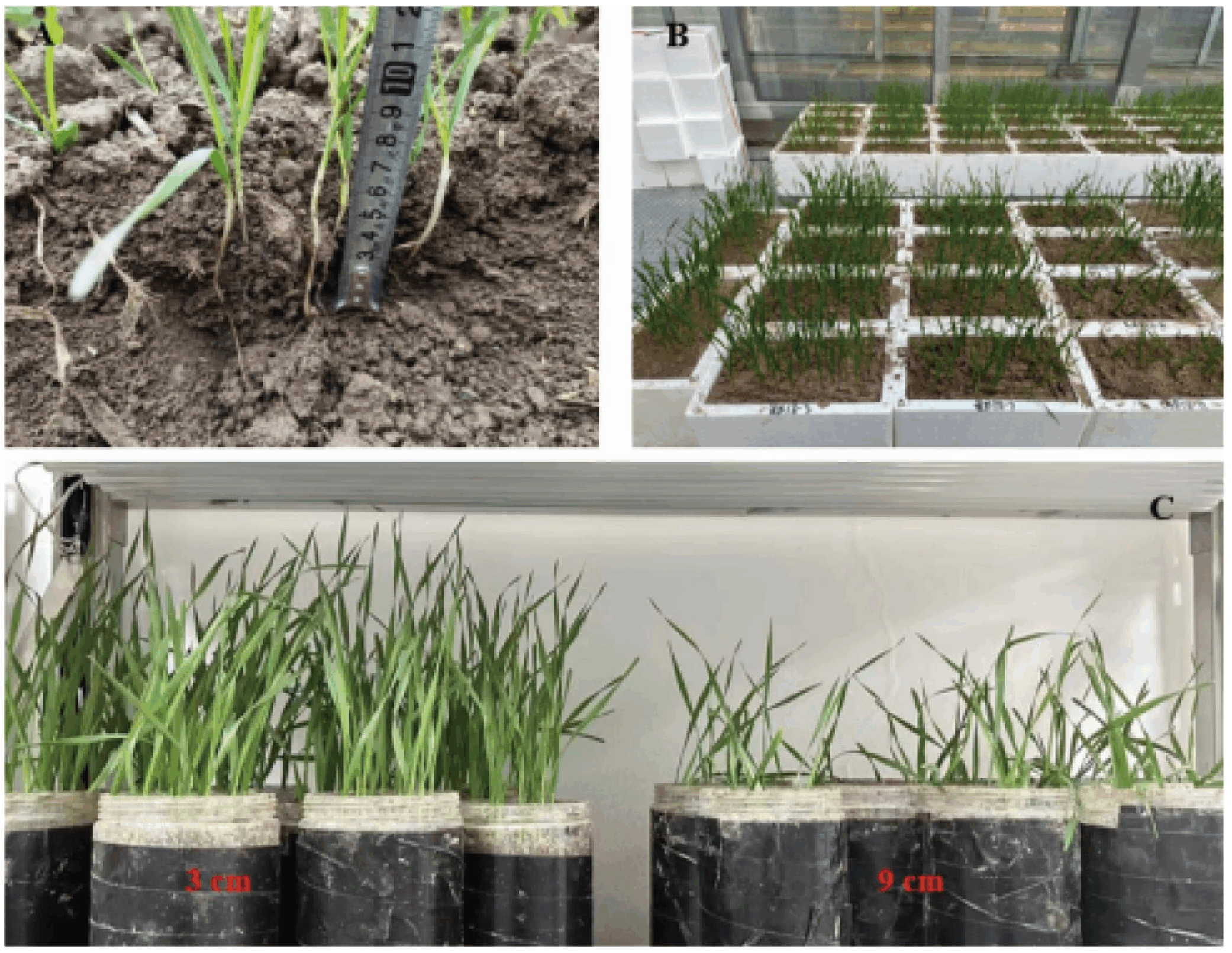

References
- Ji, H.; Xiao, L.; Xia, Y.; Song, H.; Liu, B.; Tang, L.; Cao, W.; Zhu, Y.; Liu, L. Effects of jointing and booting low temperature stresses on grain yield and yield components in wheat. Agric. For. Meteorol. 2017, 243, 33–42. [Google Scholar] [CrossRef]
- Reynolds, M.; Foulkes, J.; Furbank, R.; Griffiths, S.; King, J.; Murchie, E.; Parry, M.; Slafer, G. Achieving yield gains in wheat. Plant Cell Environ. 2012, 35, 1799–1823. [Google Scholar] [CrossRef] [PubMed]
- Mou, H.; Sun, L.; Wang, Z.; Wang, Y.; Song, Y.; Zhang, R.; Duan, J.; Xie, Y.; Kang, G.; Wang, Y.; et al. Effect of nitrogen application rate and planting density on the lodging resistance and grain yield of two winter wheat varieties. Sci. Agric. Sin. 2023, 56, 2863–2879. [Google Scholar]
- Amram, A.; Fadida-Myers, A.; Golan, G.; Nashef, K.; Ben-David, R.; Peleg, Z. Effect of GA-sensitivity on wheat early vigor and yield components under deep sowing. Front. Plant Sci. 2015, 6, 487–496. [Google Scholar] [CrossRef]
- Zhou, F.; Cheng, Q.; Jin, R.; Du, L.; Li, X.; Chen, X.; Liu, B.; Yuan, J.; Kong, F. Effects of kernel size and sowing depth on maize root growth in the middle Sichuan hilly area. Chinese J. Eco-Agric. 2019, 27, 1799–1811. [Google Scholar]
- Zhu, R.; Zhao, M.; Yao, Y.; Li, Y.; Li, X.; Liu, Z. Effects of straw returning methods and sowing depth on soil physical properties and emergence characteristics of summer peanut. Acta Agron. Sin. 2024, 50, 2106–2121. [Google Scholar]
- Zuo, Q.; Kuai, J.; Zhao, L.; Hu, Z.; Wu, J.; Zhou, G. The effect of sowing depth and soil compaction on the growth and yield of rapeseed in rice straw returning field. Field Crops Res. 2017, 203, 47–54. [Google Scholar] [CrossRef]
- Schillinger, W.F.; Donaldson, E.; Allan, R.E.; Jones, S.S. Winter wheat seedling emergence from deep sowing depths. Agron. J. 1998, 90, 582–586. [Google Scholar] [CrossRef]
- Brown, P.R.; Singleton, G.R.; Tann, C.R.; Mock, I. Increasing sowing depth to reduce mouse damage to winter crops. Crop Prot. 2003, 22, 653–660. [Google Scholar] [CrossRef]
- Chaichi, M.; Nemati, A.; Dadrasi, A.; Heydari, M.; Hassanisaadi, M.; Yousefi, A.R.; Baldwin, T.C.; Mastinu, A. Germination of triticum aestivum L.: Effects of soil-seed interaction on the growth of seedlings. Soil. Syst. 2022, 6, 37. [Google Scholar] [CrossRef]
- Rebetzke, G.J.; Richards, R.A.; Fettell, N.A.; Long, M.; Condon, A.G.; Forrester, R.I.; Botwright, T.L. Genotypic increases in coleoptile length improves stand establishment, vigour and grain yield of deep-sown wheat. Field Crops Res. 2007, 100, 10–23. [Google Scholar] [CrossRef]
- Zhao, Z.; Wang, E.; Kirkegaard, J.A.; Rebetzke, G.J. Novel wheat varieties facilitate deep sowing to beat the heat of changing climates. Nat. Clim. Change 2022, 12, 291–296. [Google Scholar] [CrossRef]
- Semahegn, Y.; Shimelis, H.; Laing, M.; Mathew, I. Evaluation of bread wheat (Triticum aestivum L.) genotypes for yield and related traits under drought stress conditions. Acta Agric. Scand. B Soil. Plant Sci. 2020, 70, 474–484. [Google Scholar]
- Zhou, B.; Wang, Z.; Yue, Y.; Ma, W.; Zhao, M. Comparison of yield and light-temperature resource use efficiency between wheat-maize and maize-maize cropping systems. Acta Agron. Sin. 2015, 41, 1393–1405. [Google Scholar] [CrossRef]
- Xu, C.; Mao, J.; Li, X.; Burner, D.M.; Li, C.; Hussin, S.H. Evaluation of drought tolerance in sugarcane genotypes using the membership function value of drought tolerance (MFVD). Euphytica 2023, 219, 1–13. [Google Scholar] [CrossRef]
- Wang, J.; Zhou, M.; Xu, R.; Lu, C.; Huang, Z. Studies on selecting indices and evaluation methods for barley’s (Hordeum vulgare L.) water logging tolerance. Sci. Agric. Sin. 2007, 10, 2145–2152. [Google Scholar]
- Xie, Z. Basic concepts of fuzzy sets. In Fuzzy Mathematical Methods in Agricultural Science, 3rd ed.; Huazhong University of Science and Technology Press: Wuhan, China, 1993; Volume 1, pp. 12–50. [Google Scholar]
- Zheng, J.; Mi, S.; Jing, J.; Bai, Z.; Li, C. Principal component analysis and comprehensive evaluation on physiological traits of tolerance to low phosphorus stress in wheat substitution. Sci. Agric. Sin. 2013, 46, 1984–1993. [Google Scholar]
- Rebetzke, G.J.; Bruce, S.E.; Kirkegaard, J.A. Longer coleoptiles improve emergence through crop residues to increase seedling number and biomass in wheat (Triticum Aestivum L.). Plant Soil. 2005, 272, 87–100. [Google Scholar] [CrossRef]
- Gooding, S.; Botwright Acuna, T.L.; Fox, P.N.; Wade, L.J. Emergence, stand establishment and vigour of deep-sown Australian and CIMMYT wheats. Anim. Prod. Sci. 2006, 46, 1167–1175. [Google Scholar] [CrossRef]
- Singh, P.; Ibrahim, H.M.; Flury, M.; Schillinger, W.F.; Knappenberger, T. Critical water potentials for germination of wheat cultivars in the dryland northwest USA. Seed Sci. Res. 2013, 23, 189–198. [Google Scholar] [CrossRef]
- Schillinger, W.F.; Schofstoll, S.E.; Smith, T.A.; Jacobsen, J.A. Laboratory method to evaluate wheat seedling emergence from deep planting depths. Agron. J. 2017, 109, 2004–2010. [Google Scholar] [CrossRef][Green Version]
- Grzesiak, M.T.; Szczyrek, P.; Rut, G.; Ostrowska, A.; Hura, K.; Rzepka, A.; Hura, T.; Grzesiak, S. Interspecific differences in tolerance to soil compaction, drought and waterlogging stresses among maize and triticale genotypes. J. Agron. Crop Sci. 2015, 201, 330–343. [Google Scholar] [CrossRef]
- Yasin, M.; Andreasen, C. Effect of reduced oxygen concentration on the germination behavior of vegetable seeds. Hortic. Environ. Biotechnol. 2016, 57, 453–461. [Google Scholar] [CrossRef]
- Ozbingol, N.; Corbineau, F.; Come, D. Responses of tomato seeds to osmoconditioning as related to temperature and oxygen. Seed Sci. Res. 1998, 8, 377–384. [Google Scholar] [CrossRef]
- Zhang, M.; Dai, R.; Zhang, S.; Jiang, H. Alleviation effects of seed soaking with H2O2 on seed germination in rape under low temperature stress. JNAU 2017, 40, 963–970. [Google Scholar]
- Matsui, T.; Inanaga, S.; Shimotashiro, T.; An, P.; Sugimoto, Y. Morphological characters related to varietal differences in tolerance to deep sowing in wheat. Plant Prod. Sci. 2002, 5, 169–174. [Google Scholar] [CrossRef]
- Takeda, K.; Takahashi, H. Varietal varation for deep-seeding tolerance in barley and wheat. Breed. Res. 1999, 1, 1–8. [Google Scholar] [CrossRef]
- Li, Y.; Wang, X.; Zhang, Y.; Li, Y.; Gou, Z.; Chen, W.; Qi, X. Study on evaluation system for deep sowing tolerance of wheat (Triticum aestivum L.) germplasms. Tcrop 2021, 41, 37–43. [Google Scholar]
- Li, Y.; Wang, X.; Zhang, Y.; Gou, Z.; Chen, W.; Qi, X. Difference of deep sowing tolerance ability in wheat germplasms. Tcrop 2017, 37, 483–490. [Google Scholar]
- Yu, J.B.; Bai, G.H. Mapping quantitative trait loci for long coleoptile in Chinese wheat landrace wangshuibai. Crop Sci. 2010, 50, 43–50. [Google Scholar] [CrossRef]
- Rebetzke, G.J.; Zheng, B.; Chapman, S.C. Do wheat breeders have suitable genetic variation to overcome short coleoptiles and poor establishment in the warmer soils of future climates? Funct. Plant Biol. 2016, 43, 961–972. [Google Scholar] [CrossRef] [PubMed]
- Suge, H.; Nishizawa, T.; Takahashi, H.; Takeda, K. Phenotypic plasticity of internode elongation stimulated by deep-seeding and ethylene in wheat seedlings. Plant Cell Environ. 1997, 20, 961–964. [Google Scholar] [CrossRef]
- Luo, H.; Hill, C.B.; Zhou, G.; Zhang, X.; Li, C. Genome-wide association mapping reveals novel genes associated with coleoptile length in a worldwide collection of barley. BMC Plant Biol. 2020, 20, 346. [Google Scholar] [CrossRef] [PubMed]
- Liatukas, Z.; Ruzgas, V. Coleoptile length and plant height of modern tall and semi-dwarf european winter wheat varieties. Acta Soc. Bot. Pol. 2011, 80, 197–203. [Google Scholar] [CrossRef][Green Version]
- Saeed, S.; Ullah, S.; Amin, F.; Al-Hawadi, J.S.; Okla, M.K.; Alaraidh, I.A.; AbdElgawad, H.; Liu, K.; Harrison, M.T.; Saud, S.; et al. Salicylic acid and tocopherol improve wheat (Triticum aestivum L.) physio-biochemical and agronomic features grown in deep sowing stress: A way forward towards sustainable production. BMC Plant Biol. 2024, 24, 477. [Google Scholar] [CrossRef]
- Wang, F.; Feng, Z.; Yang, X.; Zhou, G.; Peng, Y. Physiological parameters and transcriptomic levels reveal the response mechanism of maize to deep sowing and the mechanism of exogenous MeJA to alleviate deep sowing stress. Int. J. Mol. Sci. 2024, 25, 10718. [Google Scholar] [CrossRef]
- Yang, W.; Xu, D.; Li, S.; Tang, X.; Pan, S.; Chen, X.; Mo, Z. Emergence and seedling establishment of rice varieties at different sowing depths. J. Plant Growth Regul. 2021, 41, 1672–1686. [Google Scholar] [CrossRef]
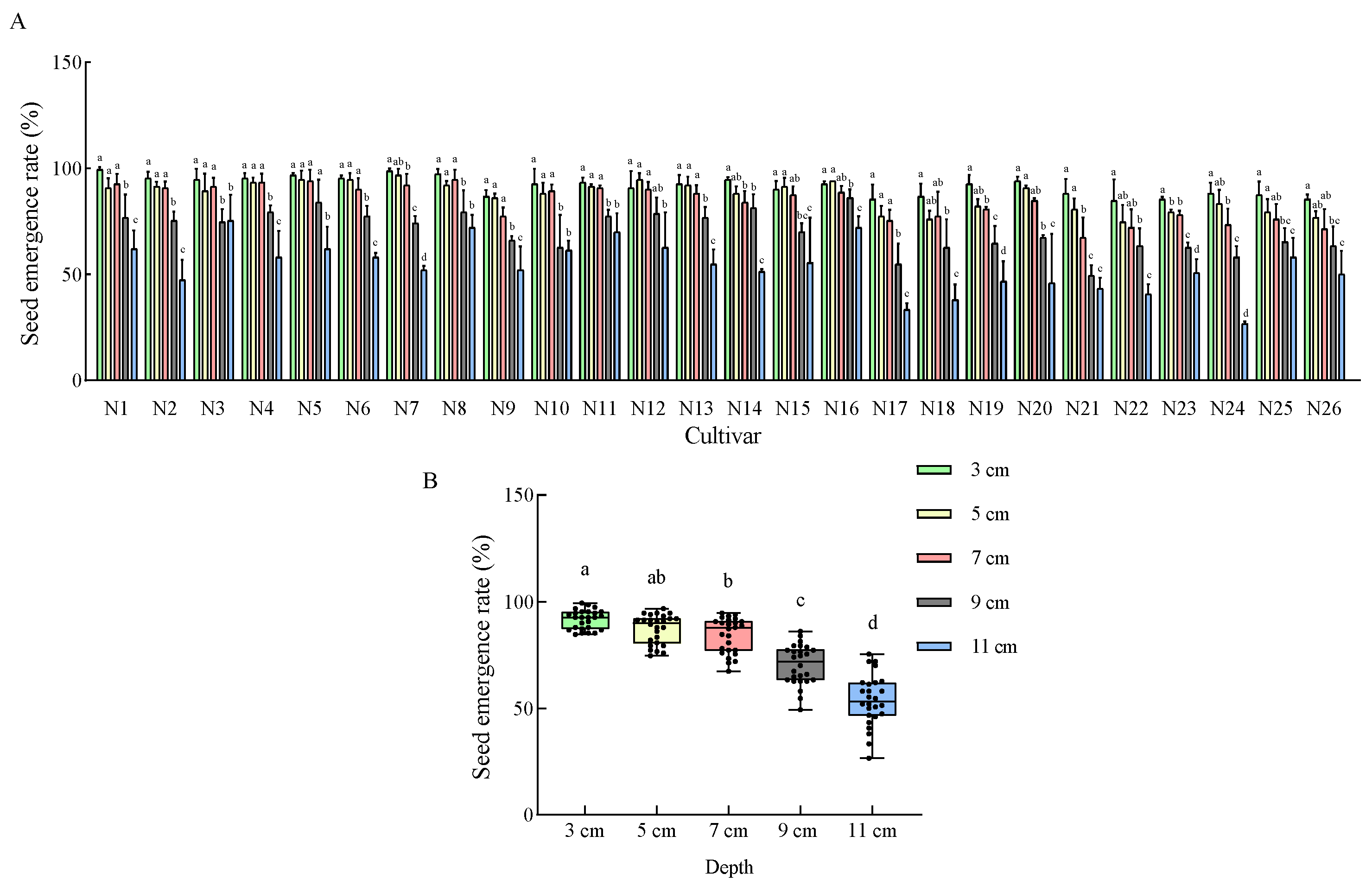
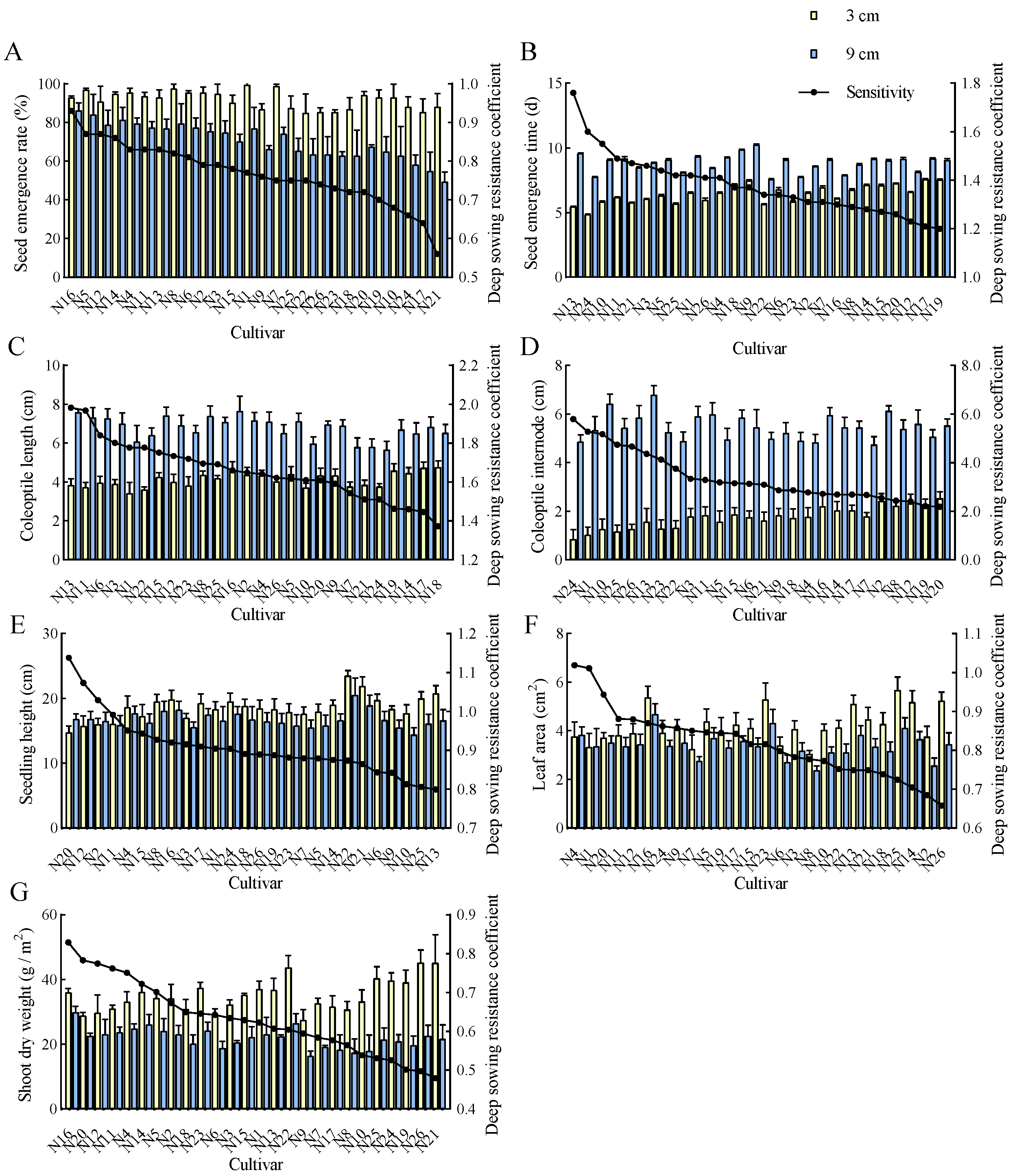
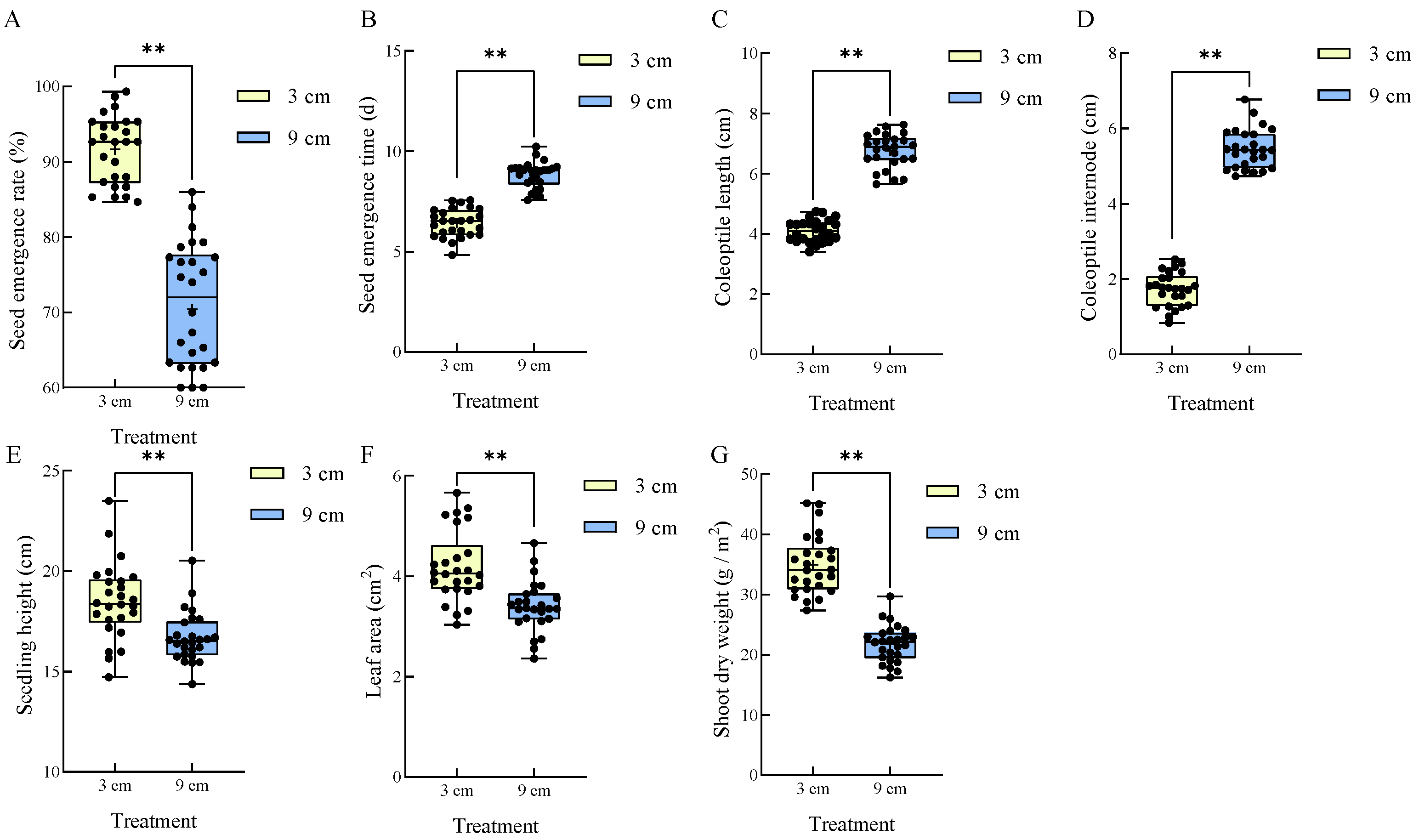
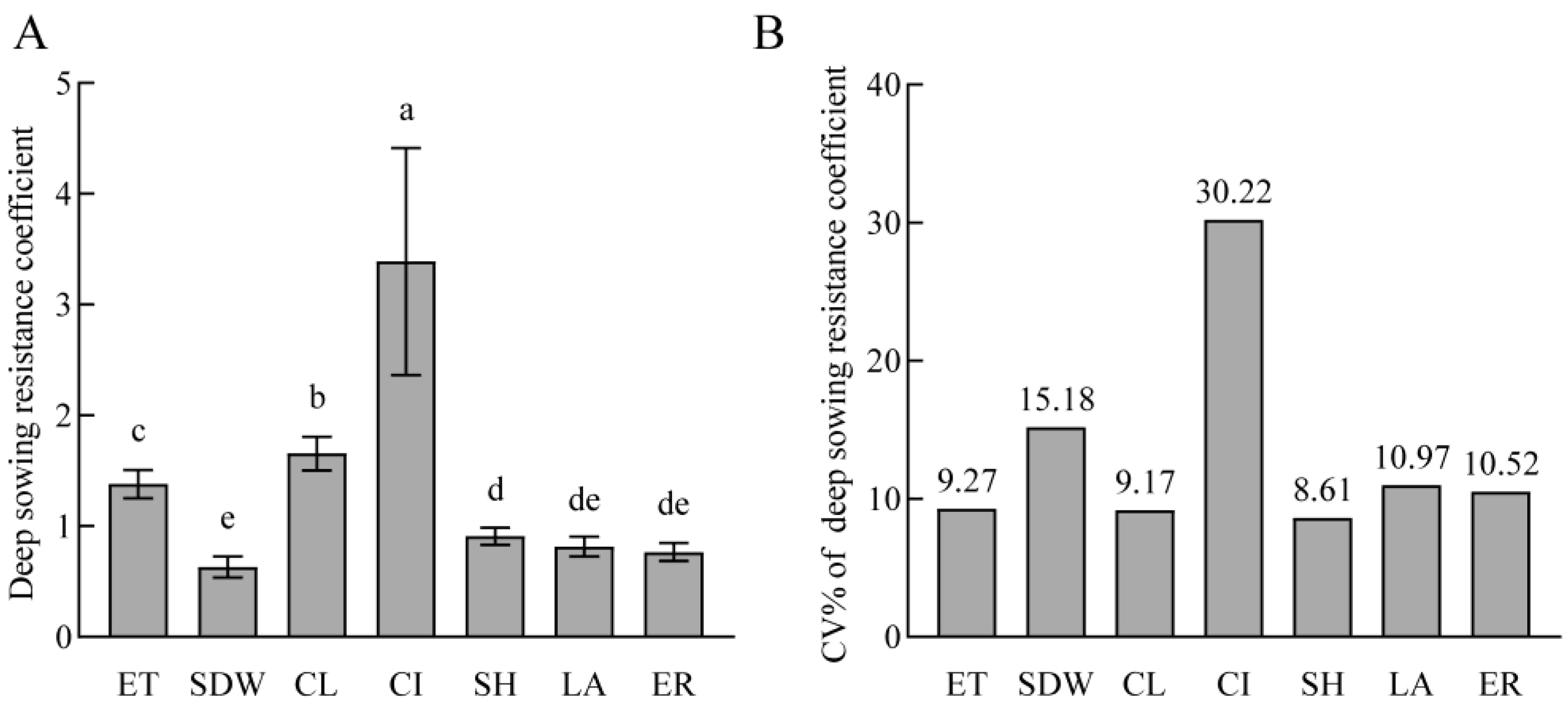
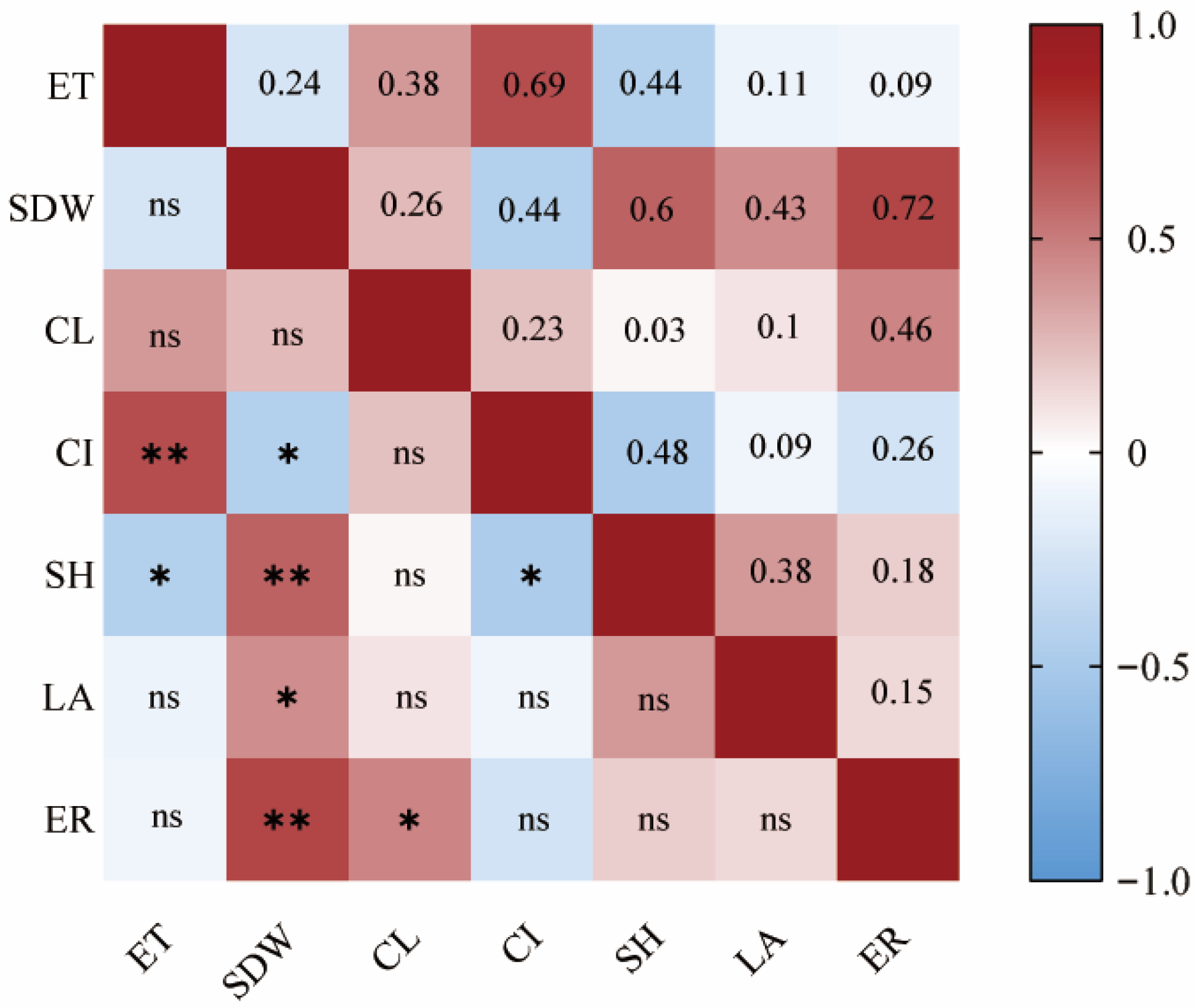
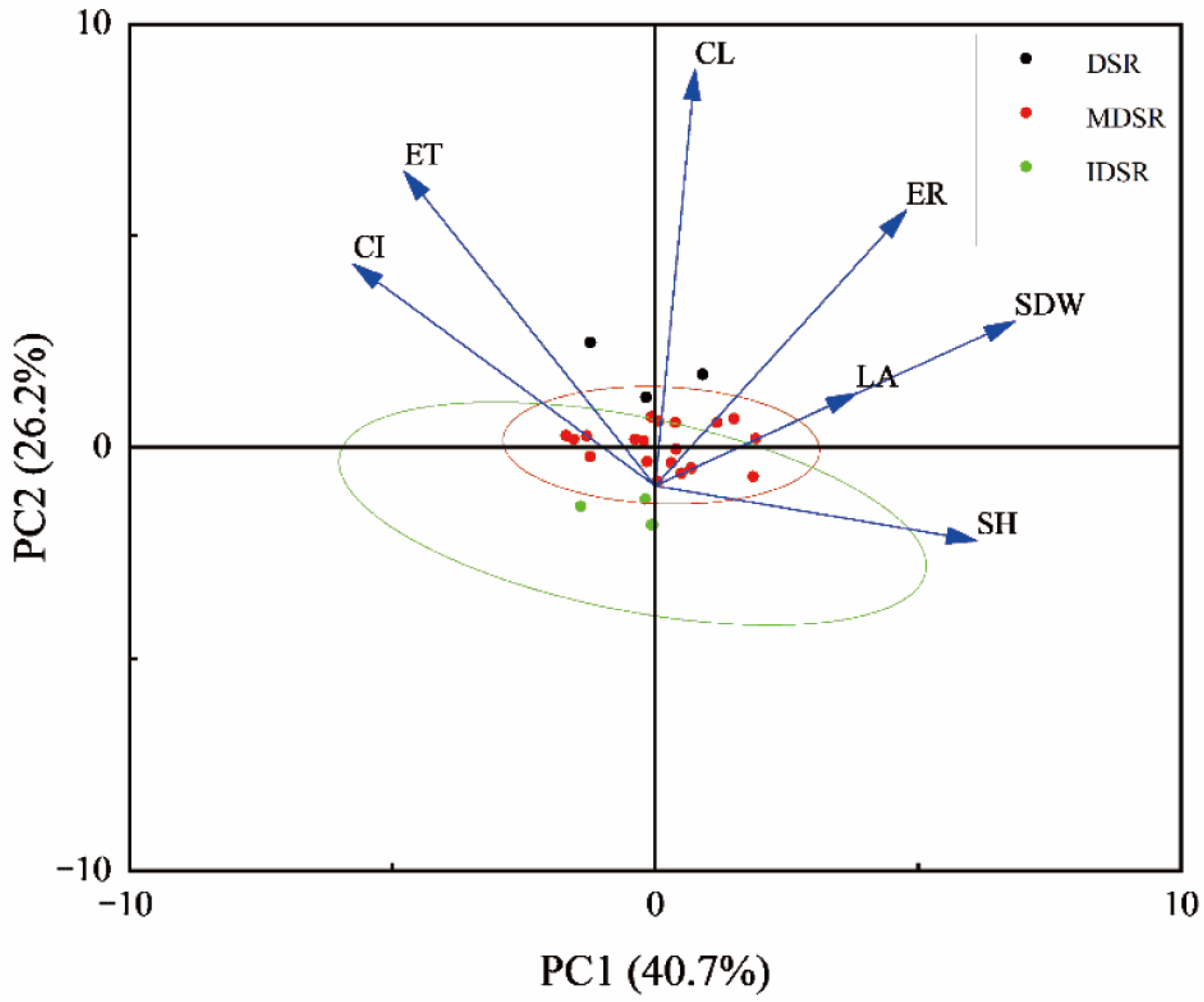

| Number | Name | Abbreviation | Number | Name | Abbreviation |
|---|---|---|---|---|---|
| 1 | Fanmai 5 | N1 | 14 | Zhengmai 1860 | N14 |
| 2 | Bainong 4199 | N2 | 15 | Zhengmai 0943 | N15 |
| 3 | Zhongmai 895 | N3 | 16 | Zhengmai 20 | N16 |
| 4 | Zhengmai 0919 | N4 | 17 | Zhengmai 369 | N17 |
| 5 | Zhengmai 661 | N5 | 18 | Fanmai 8 | N18 |
| 6 | Zhengmai 1354 | N6 | 19 | Zhoumai 22 | N19 |
| 7 | Xinmai 26 | N7 | 20 | Zhengmai 22 | N20 |
| 8 | Aikang 58 | N8 | 21 | Xinmai 45 | N21 |
| 9 | Zhengmai 662 | N9 | 22 | Zhengmai 113 | N22 |
| 10 | Xinong 511 | N10 | 23 | Hemai 1707 | N23 |
| 11 | Zhengmai 136 | N11 | 24 | Jimai 22 | N24 |
| 12 | Wanfeng 269 | N12 | 25 | Zhengmai 16 | N25 |
| 13 | Zhengmai 379 | N13 | 26 | Zhengmai 7698 | N26 |
| Classification | Wheat Varieties | ||||
|---|---|---|---|---|---|
| First kind | Zhengmai 379 | Zhengmai 136 | Fanmai 5 | ||
| Second kind | Bainong 4199 | Zhongmai 895 | Zhengmai 0919 | Zhengmai 661 | Zhengmai 1354 |
| Xinmai 26 | Aikang 58 | Zhengmai 662 | Xinong 511 | Wanfeng 269 | |
| Zhengmai 1860 | Zhengmai 0943 | Zhengmai 20 | Zhengmai 22 | Zhengmai 113 | |
| Hemai 1707 | Jimai 22 | Zhengmai 16 | Zhengmai 7698 | ||
| Third kind | Zhengmai369 | Fanmai 8 | Zhoumai 36 | Xinmai 45 | |
| Traits | ET | SDW | CL | CI | SH | LA |
|---|---|---|---|---|---|---|
| D values | 0.57 ** | 0.44 * | 0.86 ** | 0.38 | −0.01 | 0.26 |
Disclaimer/Publisher’s Note: The statements, opinions and data contained in all publications are solely those of the individual author(s) and contributor(s) and not of MDPI and/or the editor(s). MDPI and/or the editor(s) disclaim responsibility for any injury to people or property resulting from any ideas, methods, instructions or products referred to in the content. |
© 2025 by the authors. Licensee MDPI, Basel, Switzerland. This article is an open access article distributed under the terms and conditions of the Creative Commons Attribution (CC BY) license (https://creativecommons.org/licenses/by/4.0/).
Share and Cite
Yang, C.; Wang, R.; Tian, C.; Zhang, D.; Cheng, H.; Li, X.; Fang, B.; Jin, H.; Song, H.; Tian, B.; et al. The Adaptability of Different Wheat Varieties to Deep Sowing in Henan Province of China. Agronomy 2025, 15, 1466. https://doi.org/10.3390/agronomy15061466
Yang C, Wang R, Tian C, Zhang D, Cheng H, Li X, Fang B, Jin H, Song H, Tian B, et al. The Adaptability of Different Wheat Varieties to Deep Sowing in Henan Province of China. Agronomy. 2025; 15(6):1466. https://doi.org/10.3390/agronomy15061466
Chicago/Turabian StyleYang, Cheng, Rongkun Wang, Cheng Tian, Deqi Zhang, Hongjian Cheng, Xiangdong Li, Baoting Fang, Haiyang Jin, Hang Song, Baoming Tian, and et al. 2025. "The Adaptability of Different Wheat Varieties to Deep Sowing in Henan Province of China" Agronomy 15, no. 6: 1466. https://doi.org/10.3390/agronomy15061466
APA StyleYang, C., Wang, R., Tian, C., Zhang, D., Cheng, H., Li, X., Fang, B., Jin, H., Song, H., Tian, B., Wei, F., & Yan, G. (2025). The Adaptability of Different Wheat Varieties to Deep Sowing in Henan Province of China. Agronomy, 15(6), 1466. https://doi.org/10.3390/agronomy15061466






